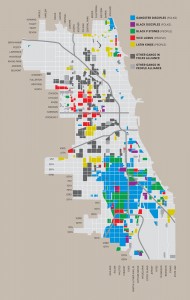Criminalizing the “Underclass” in the Public Imagination
I am serving on the advisory board for an upcoming exhibition about the history of the Conservative Vice Lords in Chicago. This will be a community-based exhibition in North Lawndale and is being curated by former CVL members, other partners and the Jane Addams Hull House Museum. So I have been thinking a little about the concept of “gangs” and their connection to violence lately.
Yesterday, Davey D shared some new music videos addressing current social issues. One of these is by Lupe Fiasco titled “Double Burger with Cheese.”
Davey D had this to say about Lupe’s new video:
His newest offering is to a song called Double Burger w/ Cheese where he goes in the power of images and how they may have impacted several generations of Black Youth.. The video starts off by showing footage from the 1965 Watts Riots and then juxtaposes it with an array of videos and images from movies in the early to mid 90s that focus both on South Central LA and the crack era..
We see footage from everything like; Juice, Menace II Society, Boyz N The Hood, New Jersey Drive, Poetic Justice, Dead Presidents, South Central, Sugar Hill, New Jack City, Paid In Full, & Colors. Although many of the movies shown have strong anti-gang messages, many of us have come to romanticize and glorify the gang drama and trauma shown in them..
I want to pick up on Davey D’s last point because I think that it is a particularly interesting one. If it is true that some people of color have internalized and romanticize gang drama and trauma, what impact does this have in our communities? Is the argument that these images make young people of color more prone to turn to violence themselves? Do the images have a desensitizing effect on those who watch them?
I actually think that these images have more impact on the dominant culture than on marginalized young people. Robin D. G. Kelley (2000) has written that:
“The mainstream media have [sic] employed metaphors of war and occupation to describe America’s inner cities. The recasting of poor urban Black communities as war zones was brought to us on NBC Nightly News, Dan Rather’s special report “48 Hours: On Gang Street,” Hollywood films like Colors and Boyz N the Hood, and a massive media blitz that has been indispensable in creating and criminalizing the so-called underclass (p.24).”
In other words, according to Kelley, the very images referenced in Lupe Fiasco’s video, were critical to creating and criminalizing the underclass in the American public imagination. These images help to legitimize the militarization of police forces and to justify tough-on-crime policies. Sociologist Zygmunt Bauman correctly points to the futility and vicious cycle of increased police repression in marginalized communities: “The sole effect of extemporary police actions is to render the need of further police actions yet more pressing: police actions, so to speak, excel in reproducing their own necessity.” A far better approach would be to address the root causes of violence in marginalized communities. Yet this gets short-shrift.
When I discuss gangs with my students, I often screen a documentary titled “Crips and Bloods: Made in America.” In particular, I like to show a clip that makes explicit the connection between economic disinvestment and the rise of gangs.
Commenting on the street violence in South Central LA in the film, Tom Hayden says: “It’s been defined as a crime problem and a gang problem, but it’s really an issue of no work and dysfunctional schools.” This is basically where I come down too. However, I know that others would offer their own ideas about the root causes of gang culture. If you have the chance, I highly recommend watching the entire documentary.

